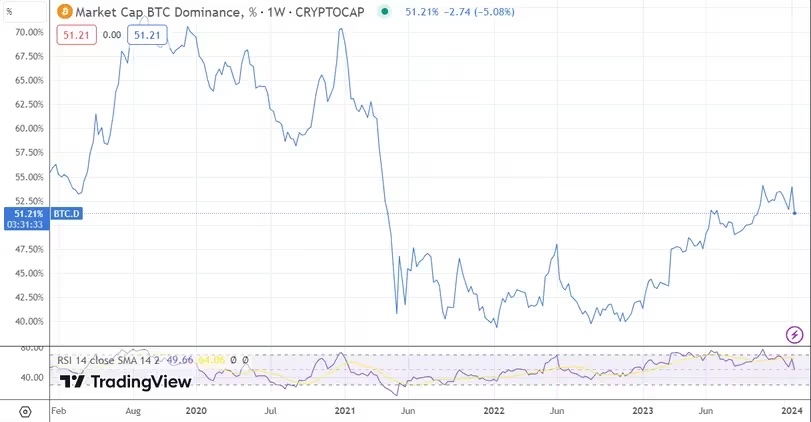
Last week’s approval of a Bitcoin spot exchange-traded fund (ETF) was a huge deal. Since its market debut on January 11, more than $4.5 billion (approximately 666 billion yen, equivalent to 148 yen to the dollar) was traded, and the Bitcoin ETF has been attracting attention from the financial industry in recent days.
That’s really impressive considering how long it took for the US Securities and Exchange Commission (SEC) to approve a Bitcoin ETF. There are definitely things in this world worth waiting for.
Reality check on the crypto asset (virtual currency) market
In 2024, the crypto asset market will grow and rival larger asset classes. Despite some economic instability and uncertainty over the past year, Bitcoin (BTC) and Ethereum (ETH) have come forward strongly, becoming increasingly popular as desirable alternatives to stocks and bonds.
Fund managers are focused on performance in 2023, which means demand for Bitcoin and Ethereum will increase.
Bitcoin spot ETF: Don’t ignore it
It is still too early to judge whether the launch week of the Bitcoin ETF was a case of “buy on rumors, sell on news,” but it is likely to be a turning point in the penetration rate of crypto assets in the medium to long term. why?
Bitcoin ETFs are a more accessible and regulated way to allocate capital to the crypto market. For example, if you look at the stock prices of Coinbase and MicroStrategy in 2023, they will outperform Bitcoin (both companies are publicly traded and you can easily buy their shares). .
Similarly, Bitcoin ETFs will open the door for Registered Investment Advisors (RIAs), pension funds, and hedge funds to enter Bitcoin investing. In addition, investment banks have started creating new financial products based on Bitcoin ETFs, and the CBOE (Chicago Board Options Exchange) is waiting to approve options for Bitcoin ETFs.
I can’t take my eyes off this field.
Fund inflow and big numbers
Get ready for a massive influx of funds into crypto assets. RIAs manage approximately $130 trillion, and by allocating just 1-2% of their portfolio to crypto assets through Bitcoin ETFs, they could generate $1-2.5 trillion, roughly equivalent to the current market capitalization of the crypto market. There is a possibility that it will be sent to the crypto asset market.
However, there is one problem. This large amount of funds will primarily flow into Bitcoin and Ethereum. Unfortunately, altcoins may have to wait their turn for the time being.
However, the rise in Bitcoin and Ethereum should spill over to other altcoins as crypto-native investors take profits in major tokens and allocate capital to tokens with smaller market caps.
This will enable crypto-native investors to compete in arbitrage between major tokens and altcoins, allowing them to take the lead in Bitcoin’s dominance.

 BTC Dominance in Market Capitalization (TradingView)
BTC Dominance in Market Capitalization (TradingView)Future of macro factors
Think about recessions and interest rates. If the U.S. economy weakens due to rising interest rates in the second half of 2024, the interest rate cycle will enter a dovish phase. Who will benefit from that? Yes, crypto assets.
Bitcoin, with its digital scarcity, and Ethereum, with its increasingly deflationary post-Merge tokenomics, will shine in a world of rising deficits, government spending, and abundant dollar liquidity. .
However, my expectations are moderate. A period of instability is inevitable, when the liquidity of crypto assets declines and deleveraging progresses.
Smart portfolio construction
In 2024, it is important not to try to predict the direction of the market. Instead, focus on portfolio construction and position sizing (determining your risk criteria in advance).
Price momentum indicators such as CoinDesk Bitcoin and Ether Trend Indicators (BTI and ETI) can be a useful source of information to adjust exposure and manage overall market exposure.
If you want altcoin exposure to take advantage of an uptrending market, consider diversifying your exposure.
Indexes like the newly launched CoinDesk 20 (CD20) target major tokens to better manage market volatility and diversify potential altcoin risks due to specific token adoption rates or regulatory impacts. Offers decentralized altcoin exposure while setting limits (30% Bitcoin, 20% Ethereum).
Prepare for altcoin season
Now is the time to consider allocating your portfolio to altcoins while still holding onto your Bitcoin and Ethereum.
Altcoins shine when the crypto market is booming, and their growth potential is undeniable. However, markets never move in a straight line and there are always unexpected developments, so keep in mind the benefits of portfolio construction.
|Translation and editing: Akiko Yamaguchi, Takayuki Masuda
|Image: Shutterstock
|Original text: Bitcoin and Ethereum to Lead Altcoins Higher in 2024
The post Bitcoin and Ethereum will make altcoins rise in 2024 | CoinDesk JAPAN appeared first on Our Bitcoin News.

 1 year ago
76
1 year ago
76














 English (US) ·
English (US) ·